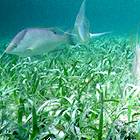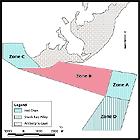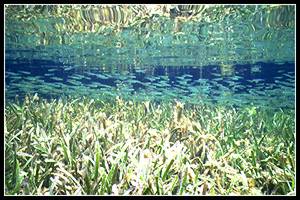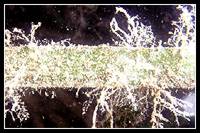|
| |

|
ZONE B
The lagoon habitat covers the largest area of the reserve, physically linking the mangrove and coral reef habitats into one continual ecosystem.
|

|
||||
 The lagoon habitat covers the largest area of the reserve, physically linking the mangrove and coral reef habitats into one continual ecosystem. The dominant flora consists of the sea grasses Thalassia and Syringodium, which occur in patches with a wide range of densities. Overall, seagrass coverage in the lagoon has been estimated at 50%. There are also other algae such as Udotea spp., Penicillus spp., sponges, and some small hard corals such as Manicina areolata and Favia fragum. Fish and invertebrates representative of this habitat are present, including a notably large population of Queen Conch. Manatee and Bottlenose dolphin have also been seen in this area.
There are two points of special interest in the lagoon zone of Hol Chan. One is the "Boca Ciega" blue hole which lies along the Northwestern border of this zone. The opening of the cavern lies in approximately 4 meters of water and is normally a gathering point for schools of fish.
Approximately fifteen species of sponges have been identified and several were unidentifiable. Among the many algae is the commercially valuable Eucheuma isoforme, used locally in "seaweed smoothies". | ||||||
| Zone A - Coral Reef | Zone B - Grass Beds | Zone C - Mangrove | Zone D - Shark-Ray Alley |
|
Copyright ©
- Naturalight Productions Ltd.
The URL of this page is: |
 The other area has been called "Neptune's Garden" and is located at the Southwestern end of this zone, actually extending beyond the border of the reserve. It consists of an unusual mixed sponge/algal bed which appears to exist in this area due to the unusually high bedrock. The average water depth has been measured at 4 feet, while the sediment thickness in this area has been measured at 1 - 4 inches, compared to 14 inches or more in bordering regions.
The other area has been called "Neptune's Garden" and is located at the Southwestern end of this zone, actually extending beyond the border of the reserve. It consists of an unusual mixed sponge/algal bed which appears to exist in this area due to the unusually high bedrock. The average water depth has been measured at 4 feet, while the sediment thickness in this area has been measured at 1 - 4 inches, compared to 14 inches or more in bordering regions.
 The multiple layer coverage of sponges and algae creates a sheltered habitat for numerous juvenile fish and invertebrates. In an adjacent area closer to the bordering mangrove zone, there is an assemblage of large loggerhead sponges. There is little seagrass in the area and the fine sediments form a thin layer over the occasionally exposed bedrock. The sponges and numerous fissures in the bedrock provide a habitat for numerous juvenile lobsters found in this area.
The multiple layer coverage of sponges and algae creates a sheltered habitat for numerous juvenile fish and invertebrates. In an adjacent area closer to the bordering mangrove zone, there is an assemblage of large loggerhead sponges. There is little seagrass in the area and the fine sediments form a thin layer over the occasionally exposed bedrock. The sponges and numerous fissures in the bedrock provide a habitat for numerous juvenile lobsters found in this area.